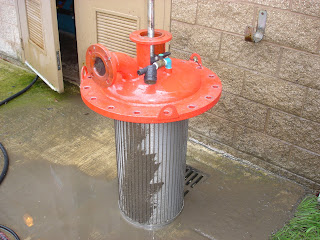Thursday, March 4, 2010
Preventative Maintenance

The irrigation system is the life and blood of a golf course in the arid western states. Since we typically do not record any precipitation for 6 months of the year, the health and aesthetics of the turf relies on a properly functioning irrigation system.
We are blessed to have a modern irrigation system and a pump house that is the best I've seen out of the seven courses I've worked for. Both of these components were installed in 2002 and are holding up very well. However, that is no reason to ignore annual maintenance of the system and wait for a problem before taking a look.
I pulled the following definition from Wikipedia and I think it describes the phrase very well.

Yesterday, Commercial Pump came out to the course to inspect and service our pump system and for the second visit in a row, they found a potentially massive problem. The hydraulic tube that senses pressure in the system was partially blocked and could mislead the computer to run the pumps until something ruptured or burned up. In addition, the computer system is water-cooled and that tubing was also partially blocked.
The pictures to the left show the removed filter that keeps most dirt and debris from entering the irrigation lines. The top photo is a good look at the brushes that periodically scrape the walls to remove buildup. The next pic shows the outside which is thoroughly washed before inspection. Finally, the last photo was taken inside the pump house. Here you can see the housing for the removed filter and the four pumps in the background.
the outside which is thoroughly washed before inspection. Finally, the last photo was taken inside the pump house. Here you can see the housing for the removed filter and the four pumps in the background.
We came through this checkup with a clean bill of health and a couple of problems resolved before disaster struck. Once the gentlemen from Commercial Pump finished putting the system back together, we needed to fire on many sprinkler heads to test everything. This is always tricky because I don't want to soak all of the golfers on the course. This time I had a different problem and that was explaining why I was irrigating during a storm that dumped over a half-inch of water on the already saturated turf.
We are blessed to have a modern irrigation system and a pump house that is the best I've seen out of the seven courses I've worked for. Both of these components were installed in 2002 and are holding up very well. However, that is no reason to ignore annual maintenance of the system and wait for a problem before taking a look.
I pulled the following definition from Wikipedia and I think it describes the phrase very well.
Preventive maintenance (PM) has the following meanings:
1.The care and servicing by personnel for the purpose of maintaining equipment and facilities in satisfactory operating condition by providing for systematic inspection, detection, and correction of incipient failures either before they occur or before they develop into major defects.

Just like maintaining your car with regular service intervals, we must maintain our irrigation system before the problem arises.
Yesterday, Commercial Pump came out to the course to inspect and service our pump system and for the second visit in a row, they found a potentially massive problem. The hydraulic tube that senses pressure in the system was partially blocked and could mislead the computer to run the pumps until something ruptured or burned up. In addition, the computer system is water-cooled and that tubing was also partially blocked.
The pictures to the left show the removed filter that keeps most dirt and debris from entering the irrigation lines. The top photo is a good look at the brushes that periodically scrape the walls to remove buildup. The next pic shows
 the outside which is thoroughly washed before inspection. Finally, the last photo was taken inside the pump house. Here you can see the housing for the removed filter and the four pumps in the background.
the outside which is thoroughly washed before inspection. Finally, the last photo was taken inside the pump house. Here you can see the housing for the removed filter and the four pumps in the background. We came through this checkup with a clean bill of health and a couple of problems resolved before disaster struck. Once the gentlemen from Commercial Pump finished putting the system back together, we needed to fire on many sprinkler heads to test everything. This is always tricky because I don't want to soak all of the golfers on the course. This time I had a different problem and that was explaining why I was irrigating during a storm that dumped over a half-inch of water on the already saturated turf.

Turning on the water during a rain event in late winter will definitely turn a few more heads than the ones sticking out the ground. Thanks for your understanding.
Subscribe to:
Post Comments (Atom)


0 comments:
Post a Comment